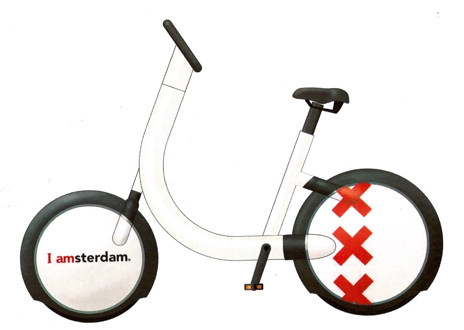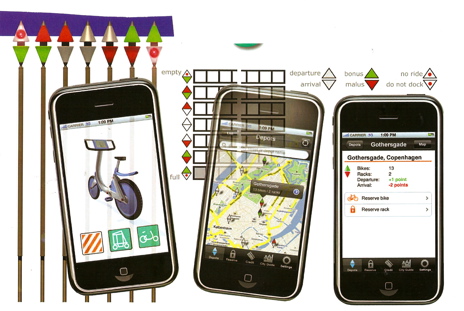Urban Biking's Next Generation: 5 Snazzy Innovations
Bike sharing is bursting out all over, and Paris' Vélib system was the urban bike sharing breakthrough that really started this fast-spreading trend. In México City there's now Ecobici (1,100 bikes); in Teheran there's Bike House (around 425 bikes), in India there's FreMo (100 bikes), and in Denver the much-hyped B-cycle will kick off on Earth Day. And what does the father of bike sharing, Luud Schimmelpinnink - he conceived the White Bicycle system back in 1965 - think of all this? While happy that elements of his vision for bike-based inner-city travel is coming true globally, Schimmelpennink is eager for the fourth generation of urban bike sharing to appear, and (surprise!) he's got a design for a system that integrates the features that many believe will grace bike sharing and urban biking's future.

A simple bike design with a back-wheel 250 w electric assist motor. Credit Ytech.
1. The Bike Sharing Future Is Electric.
Schimmelpennink's design for a sturdy bike for Amsterdam and other bike-friendly cities is based on a pedal-assist electric bike with a chainless shaft drive and a hub motor in the back wheel. The rest of the bike's electronics are neatly hidden in the frame tubing. Schimmelpennink said electric assist is necessary in the next generation of bikes for a couple of reasons. The first is to appeal to a wider field of riders - while Amsterdam is generally flat and has a fairly small inner city loaded with bike lanes, in other cities hills are a minor to intermediate challenge for riders.
In addition, however, the electric component of the bike is important for system maintenance and control. When the bike leaves a designated city area, the system can via GPS find the bike and reduce power to to the pedals, making it difficult to ride. In addition, inside the city, the system can curtail excessive bike speeds by reducing power to the pedals, cutting down on the risk of accidents (but adding a bit of a Big Brother element).
"Headwinds, hills, and lack of physical strength will no longer be a problem for its riders." - Ytech White Bikes brochure

WiFi-enabled poles will indicate availability of bikes and parking. Credit Ytech.
2. Distribution Control Is Key.
The next generation of bike sharing, especially for larger, more far-flung cities, has got to include smart distribution systems, Schimmelpennink says. In fact, getting distribution down was an early challenge for the Paris Vélib system, as users tended to congregate at high-traffic stations at key rush hour moments (and after party hours on weekends), and experienced frustration if bikes were not available at their nearest location or if they were unable to return a bike because a station was full of bikes. Schimmelpennink says his updated White Bike system, which is driven by a smart card similar to the Hong Kong Octopus, Paris Navigo Amsterdam OV card, solves that issue with software and user perks. An iPhone application uses small, diamond-shaped indicators to represent the WiFi poles at each bike station location. If the on-screen diamond show both top and bottom green, the station has bikes available as well as storage space. However, if either bike availability or parking space is low, the system will reward a user with plus points for returning to a less busy location.
Paying for sharing is based on a point system. if a user insists on taking a bike for drop off at a nearly-full location, the user's card might take two points off of an existing card balance. If the biker instead drops the bike at a location that needs inventory, one bonus point could be added to the balance. In this way the system places responsibility for bike distribution on the traveller rather than the operator - Paris has an entire fleet of trucks with trailers used to move bikes around where they are needed, which incurs a high maintenance cost. One of the winning entries to the Copenhagen Bike Share contest last December also had an electric component and proposed using a smart card and software to create a flexible sharing system "completely independent"* of fixed depot stations.

In Schimmelpennink's vision, a truly versatile bike sharing plan covers the city and provides free parking at the edges. Credit Ytech.
3. Anti-Theft Plus Puncture Proof Tires.
The updated White Bike, in Schimmelpennink's vision, is as streamlined as it can be but still has a wealth of high-tech features. The tires, according to the designer, will only need to be filled with air once every two years, as their puncture-proof protective polycarbonate exterior cap will protect the air tube inside for much longer than a normal bike tire.
White Bike is also supposed to be protected from theft by its smart card locking system. (Of course, no smart card prevents vandals from chucking these bikes into the nearest canal.) The bike does require a card swipe to lock and unlock it. Only when it is unlocked can the kick stand be kicked back. In addition, swiping the smart card also engages and unblocks the back wheel to allow for pedaling.
Lastly, because the bike's electronics are located in the tube frame, the seat is raised or lowered to the five pre-set heights electronically by means of a button - the saddle is integrated into the stem, making it nearly impossible to take out.
Check-out at the current Amsterdam bike sharing program, OV Fiets, is fast, yet requires an on-site attendant. Photo credit April Streeter.
4. High-Tech Bike, Low-Tech Station.
The designers of White Bike seem to believe that bike sharing depots should be relatively low-tech with as little hardward as possible, able to fit neatly into jam-packed city streets and with no need for the large, ATM-like kiosk stands that characterize the current generation of bike sharing programs. The compact depots of this fourth-generation system will have charging stations to keep the bikes freshly charged, and a WiFi signal pillar is necessary to relay information on the number of bikes and places available, but the booking and payment kiosk will not be needed.
"Expensive bicycles, but cheap depots." - Ytech White Bike brochure
5. Integration With Car Sharing System.
According to Schimmelpennink, the first generation of bike sharing was his very own White Bike system from 1965. In Schimmelpennink's recollection, the White Bikes were meant as a provocation (the political group he was a part of at the time was called "Provo") rather than a real functional system. The next generation of bike sharing was a system such as in Copenhagen, where heavy, low-to-the-ground cruisers can be rented from the train station and nearby locations simply by inserting a coin into the lock.
The third generation, Schimmelpennink said, is typified by the OV-fiets system implemented quite recently in bike-loving Amsterdam. OV-fiets is quite streamlined - users hop off the train and duck into an adjoining depot where they pick up a bike, which is scanned with a hand scanner and away the rider goes. However, bikes must be returned to the same location, to an attendant at the depot. In Schimmelpennink's view, the fourth generation bikes will cost as much or more than bike sharing cycles do now (he estimates around €2,500 per bike) but docking depots will be less expensive, costing approximately €1,000.
In addition, Schimmelpennink envisions a city-wide system that integrates a car-sharing element with the bike-sharing system.
"What I want to do is make a total system for the town itself," he said.
To be called White Car (Witkar), Schimmelpennink's idea for car sharing is to have electric-powered vehicles looking somewhat like a GM Segway and getting free parking at various locations around a city. He has experience - Schimmelpennink implemented a functioning system in Amsterdam called Witkar in 1978; it lasted until 1986 and was one of the first implementations of a "smart card" to lock and unlock a user's car). White car cars would go no more than 40 kilometers per hour they would carry just two people and a small amount of cargo..
Schimmelpennink is hoping to have a working prototype of the White Bike ready for testing by December 2010 - he is currently in communication with the city of Barcelona to run a pilot program.
From Treehugger.com
